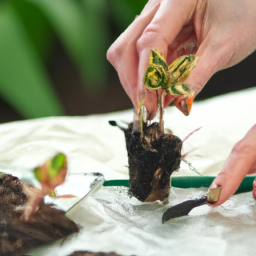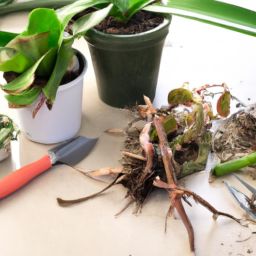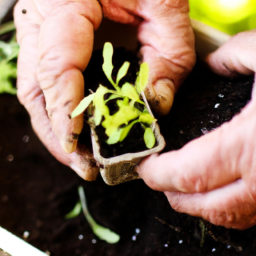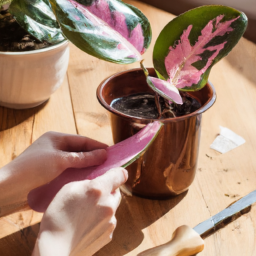
Are you ready to take your gardening skills to the next level? If you’re interested in expanding your plant collection and creating an abundance of greenery, then mastering plant propagation techniques and tips for success is essential. Whether you’re a seasoned gardener or just starting out, understanding how to propagate plants can be a game-changer. In this blog post, we’ll explore various plant propagation techniques and provide you with valuable tips to ensure your success in this rewarding endeavor. So, grab your gardening tools and let’s dive into the world of plant propagation!
The Importance of Proper Plant Propagation Techniques
Introduction
Proper plant propagation techniques are crucial for the success of any gardener or plant enthusiast. Whether you are a beginner or an experienced gardener, mastering these techniques will not only help you save money but also allow you to expand your plant collection and share your favorite plants with others. In this guide, we will explore the importance of proper plant propagation techniques and provide you with step-by-step tips for success.
Understanding Plant Propagation
Plant propagation refers to the process of creating new plants from existing ones. It is a way to reproduce plants without relying solely on seeds. By using various propagation methods, you can create identical clones of your favorite plants or produce new varieties through cross-pollination. Proper plant propagation techniques ensure the successful growth and development of the new plants.
The Benefits of Proper Plant Propagation Techniques
1. Preservation of Rare and Endangered Species: Many plant species are at risk of extinction due to habitat destruction and human activities. By mastering plant propagation techniques, you can contribute to the preservation of rare and endangered plants. By propagating these plants, you can help increase their numbers and ensure their survival for future generations.
2. Cost Savings: Buying new plants can be expensive, especially if you have a large garden or want to experiment with different varieties. By propagating plants from cuttings or divisions, you can save money and expand your collection without breaking the bank. With proper techniques, you can create multiple new plants from a single parent plant, multiplying your garden’s beauty without spending a fortune.
3. Sharing Plants with Others: Plant propagation allows you to share your favorite plants with friends, family, and fellow gardeners. By propagating your plants, you can give others the opportunity to enjoy the beauty and benefits of the plants you love. It’s a wonderful way to connect with others who share your passion for gardening and create a sense of community.
Step-by-Step Guide to Mastering Plant Propagation Techniques
Step 1: Selecting the Parent Plant
Choose a healthy and mature parent plant for propagation. Look for plants that have strong growth, disease-free foliage, and no signs of pests. Selecting the right parent plant is crucial as it ensures the quality of the propagated plants.
Step 2: Choosing the Propagation Method
There are several propagation methods to choose from, including stem cuttings, leaf cuttings, division, layering, and grafting. Each method has its own requirements and suitability for different plant species. Research and select the best method for the specific plant you want to propagate.
Step 3: Preparing the Propagation Medium
Prepare a suitable propagation medium depending on the chosen method. It can be a mix of soil, perlite, vermiculite, or a specialized rooting medium. Ensure the medium is well-draining and sterile to prevent diseases and promote healthy root development.
Step 4: Taking Cuttings or Divisions
If using stem cuttings or leaf cuttings, take them from the parent plant using clean and sharp tools. Make sure the cuttings are of appropriate length and have at least one node or leaf. For division, carefully separate the parent plant into several sections, ensuring each section has enough roots and foliage.
Step 5: Applying Rooting Hormones (if necessary)
Some plant species benefit from the use of rooting hormones to stimulate root growth. Follow the instructions on the rooting hormone product and apply it to the cut end of the stem or leaf before planting.
Step 6: Planting and Caring for Propagated Plants
Plant the cuttings or divisions in the prepared propagation medium. Ensure they are planted at the appropriate depth and provide proper watering and light conditions. Monitor the plants closely for signs of stress, pests, or diseases, and take necessary actions to ensure their well-being.
Conclusion
Mastering plant propagation techniques is a valuable skill for any gardener or plant enthusiast. By understanding the importance of proper propagation techniques and following a step-by-step guide, you can successfully create new plants, preserve rare species, save money, and share your love for plants with others. Remember to choose healthy parent plants, select the appropriate propagation method, and provide proper care to ensure the success of your propagated plants. Happy propagating!

Mastering Plant Propagation Techniques and Tips for Success
2. Essential Tips for Successful Plant Propagation
Welcome to the world of plant propagation! Whether you’re a seasoned gardener or just starting out, mastering plant propagation techniques can be a rewarding and fulfilling experience. In this guide, we will explore some essential tips for successful plant propagation that will help you grow healthy and thriving plants.
Understanding Plant Propagation
Before we dive into the tips, let’s first understand what plant propagation is all about. Plant propagation is the process of creating new plants from existing ones. It can be done through various methods such as seed sowing, stem cuttings, division, grafting, and layering. Each method has its own advantages and is suitable for different types of plants.
When propagating plants, it’s important to consider the specific needs of the plant species you’re working with. Factors like temperature, humidity, light, and soil conditions play a crucial role in the success of plant propagation. Now, let’s delve into the essential tips that will help you achieve success in your plant propagation endeavors.
Tip 1: Choosing the Right Plant Propagation Method
The first step towards successful plant propagation is choosing the right method for the specific plant you want to propagate. As mentioned earlier, there are various methods available, each with its own set of advantages. For example, stem cuttings are commonly used for plants like roses and herbs, while division works well for perennials like hostas and daylilies.
Research the plant species you’re working with to determine the most suitable propagation method. Consider factors like the plant’s growth habit, root structure, and overall health. By selecting the appropriate method, you increase the chances of successful propagation.
Once you’ve chosen the method, gather all the necessary tools and materials. This may include sharp pruning shears, rooting hormone, sterile potting mix, containers, and labels. Having everything prepared in advance will make the propagation process smoother and more efficient.
Tip 2: Timing is Everything
Timing plays a crucial role in plant propagation. Most plants have specific seasons or periods when they are most receptive to propagation. For example, many woody plants are best propagated during late winter or early spring when they are dormant. On the other hand, herbaceous plants may be propagated during their active growing season.
Research the specific plant species you’re working with to determine the ideal timing for propagation. This will vary depending on factors like climate, region, and the specific variety of plant. By propagating at the right time, you give your plants the best chance of success.
It’s also important to consider the weather conditions when propagating plants. Extreme temperatures or adverse weather conditions can negatively impact the success of propagation. Ensure that the conditions are favorable for the specific plant species you’re working with.
Tip 3: Providing Optimal Growing Conditions
Once you’ve chosen the right method and timing, it’s crucial to provide optimal growing conditions for your propagated plants. This includes factors like light, temperature, humidity, and soil conditions.
Light is essential for plant growth, so ensure that your propagated plants receive adequate sunlight or artificial light if necessary. Different plant species have varying light requirements, so research the specific needs of your plants to provide the right amount of light.
Temperature and humidity also play a significant role in plant propagation. Most plants prefer temperatures between 65-75°F (18-24°C) and moderate humidity levels. However, specific plant species may have different temperature and humidity requirements. Creating a suitable microclimate for your propagated plants will greatly enhance their chances of success.
Lastly, soil conditions are crucial for healthy plant growth. Use a well-draining and nutrient-rich potting mix for your propagated plants. Ensure that the soil is moist but not waterlogged, as excessive moisture can lead to root rot and other issues.
By providing optimal growing conditions, you create an environment that promotes healthy root development and overall plant growth.
With these essential tips, you’re well on your way to mastering plant propagation techniques. Remember to choose the right method, consider timing, and provide optimal growing conditions for your plants. Happy propagating!

Mastering Advanced Plant Propagation Techniques for Better Results
Introduction
Propagation is a fascinating aspect of gardening that allows you to create new plants from existing ones. While basic plant propagation techniques are commonly known, mastering advanced techniques can take your gardening skills to the next level. In this guide, we will explore some advanced plant propagation techniques and provide tips for success, helping you achieve better results in your gardening endeavors.
Grafting
Grafting is a technique that involves joining the tissues of two different plants to create a new plant with desirable characteristics. This technique is commonly used to propagate fruit trees, roses, and many other plants. To successfully graft plants, follow these steps:
1. Select compatible plants: Choose a scion (the part of the plant to be grafted) and a rootstock (the plant that provides the root system). Ensure that the two plants are compatible and have similar growth habits.
2. Prepare the plants: Make clean, slanting cuts on both the scion and the rootstock. The cuts should match in size and shape to ensure a snug fit.
3. Join the plants: Place the cut surfaces of the scion and the rootstock together, ensuring that the cambium layers align. Use grafting tape or a grafting clip to hold the plants firmly in place.
4. Provide support: To ensure successful grafting, provide support to the newly grafted plant. This can be done by using a stake or tying the plant to a trellis.
5. Monitor and care for the grafted plant: Regularly check the graft union for signs of healing or any potential issues. Water and provide appropriate care to promote healthy growth.
Air Layering
Air layering is a technique used to propagate plants that are difficult to root from cuttings. This method allows you to create a new plant by encouraging a stem to develop roots while still attached to the parent plant. Follow these steps for successful air layering:
1. Select a healthy stem: Choose a stem that is flexible and about the thickness of a pencil. Make a small upward cut about one-third of the way through the stem.
2. Apply rooting hormone: Apply a rooting hormone to the cut area to stimulate root growth. This will increase the chances of successful air layering.
3. Enclose the cut area: Surround the cut area with a moist sphagnum moss or a mixture of peat moss and perlite. Wrap the moss tightly with plastic wrap or aluminum foil, ensuring it remains moist.
4. Monitor and wait: Check the moisture level of the moss regularly to ensure it stays moist. After a few weeks, roots should start to develop. Once roots are well-established, carefully cut below the rooted area and pot up the new plant.
5. Provide proper care: Transplant the newly rooted plant into a suitable pot or planting location. Water and care for it as you would for any other plant, ensuring it receives adequate sunlight and nutrients.
Tissue Culture
Tissue culture is an advanced propagation technique that involves growing plants from small tissue samples in a laboratory setting. This method allows for the rapid production of large quantities of plants with desirable traits. Here are the basic steps involved in tissue culture:
1. Collect tissue samples: Select a healthy plant and collect small tissue samples, such as leaf or stem sections. Ensure the samples are free from diseases or pests.
2. Sterilize the samples: Treat the tissue samples with a sterilizing agent to eliminate any microorganisms that may interfere with the culture.
3. Establish a culture: Place the sterilized tissue samples on a nutrient-rich agar medium in a sterile container. This provides the necessary nutrients for the growth of new plants.
4. Promote growth: Provide the culture with suitable environmental conditions, including temperature, light, and humidity. This will encourage the growth of new shoots and roots.
5. Transplant and acclimatize: Once the new plants have developed, carefully transfer them to a sterile growing medium. Gradually acclimatize the plants to the outside environment before transplanting them to their final location.
Conclusion
Mastering advanced plant propagation techniques opens up a world of possibilities in gardening. Grafting, air layering, and tissue culture are just a few examples of the advanced techniques you can explore. By following the step-by-step guides provided, you can successfully propagate plants with better results. Remember to be patient and attentive to the needs of each technique, and soon you’ll be enjoying the rewards of your propagation skills. Happy gardening!
Let’s recap
Plant propagation is a fascinating and rewarding skill that every gardener should master. Whether you want to expand your garden or simply save money by growing your own plants, learning the art of plant propagation can be a game-changer. In this blog post, we will explore some essential techniques and tips to help you succeed in propagating plants like a pro.
First and foremost, it’s crucial to understand the different methods of plant propagation. From seeds and stem cuttings to division and layering, each technique has its own set of requirements and advantages. For beginners, starting with easy-to-propagate plants like succulents or herbs can be a great way to build confidence and gain experience. Once you’ve chosen the right method for your plant, it’s time to gather the necessary tools and materials. Sharp and sterile pruning shears, rooting hormone, well-draining soil, and containers are some of the essentials you’ll need to ensure successful propagation. Additionally, timing plays a crucial role in the success of your propagation efforts. Understanding the specific requirements of each plant, such as the ideal time for taking cuttings or sowing seeds, will greatly increase your chances of success. Finally, providing the right conditions for your propagated plants is vital. Maintaining consistent moisture levels, providing adequate light, and protecting them from extreme temperatures are some key factors to consider. With patience, practice, and a little bit of experimentation, you’ll soon become a master at plant propagation, enjoying the satisfaction of watching your garden flourish with your own propagated plants.
Common Questions and Answers:
Q1: What is plant propagation and why is it important?
A1: Plant propagation is the process of creating new plants from existing ones. It is important because it allows us to reproduce plants with desirable traits, expand our garden or landscape, and save money by growing plants from seeds or cuttings instead of purchasing them.
Q2: What are the different methods of plant propagation?
A2: There are several methods of plant propagation, including seed sowing, stem cuttings, leaf cuttings, division, layering, and grafting. Each method has its own advantages and is suitable for different types of plants.
Q3: How can I successfully propagate plants from stem cuttings?
A3: To propagate plants from stem cuttings, choose a healthy and mature stem, remove any flowers or buds, and make a clean cut just below a node. Dip the cut end in a rooting hormone powder, if desired, and plant it in a well-draining potting mix. Keep the cutting moist and in a warm, bright location until roots develop.
Q4: What are some tips for successful plant propagation from seeds?
A4: When propagating plants from seeds, it’s important to use fresh and viable seeds. Follow the specific instructions for each plant species regarding seed treatment, such as scarification or stratification. Provide the seeds with the right conditions, including proper soil, moisture, temperature, and light. Patience is key, as germination can take time.
Q5: How can I improve my success rate in plant propagation?
A5: To improve your success rate in plant propagation, ensure you have good hygiene practices by using clean tools and sterile containers. Pay attention to the specific needs of each plant species, such as the right temperature, humidity, and light levels. Experiment with different propagation methods to find what works best for each type of plant. Keep learning and seeking knowledge from reliable sources to refine your techniques.
Dr. Olivia Green is a botanist with over two decades of experience in indoor plant cultivation. She holds a Ph.D. in Plant Biology and has dedicated her career to researching plant behavior in controlled environments. Dr. Green is passionate about helping plant enthusiasts master the art of indoor gardening through her extensive knowledge and practical insights.


